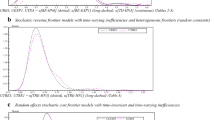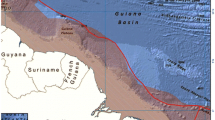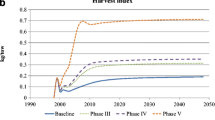Abstract
A stochastic production frontier was used to measure the initial (i.e., bi-weekly) economic effects of hurricanes on commercial grouper (Serranidae) production in the Exclusive Economic Zone of the United States Gulf of Mexico from 2005 to 2009. We estimated the economic effects of productivity losses associated with specific hurricanes on the commercial grouper fleet. We also calculated the economic effects due to productivity losses during an entire hurricane season at the regional level. The empirical model controls for input levels as well as other factors affecting production to isolate the initial economic effect caused by hurricanes from other non-weather-related factors. The empirical results revealed that hurricanes striking the Gulf of Mexico coastline from 2005 to 2009 had a negative effect on the production of the commercial grouper fleet. The results also demonstrated the relative importance of inputs and regulations on fish production.


Similar content being viewed by others
Notes
In this study, we focus on the effect of hurricanes on fish production; however, hurricanes may also impact the commercial sector by damaging shore-side infrastructure, including boat yards, ice houses, processors, bait and tackle shops, seafood dealers, and repair shops, leading to support and supply chain problems which would further reduce landings and consequently lead to a loss of income.
Federal waters encompassing the US EEZ in the Gulf of Mexico extend to 200 nautical miles offshore from the nine-mile seaward boundary of the states of FL and TX, and the three-mile seaward boundary of the states of Alabama, Mississippi, and Louisiana.
SWG species include red (Epinephelus morio), black (Mycteroperca bonaci), gag (Mycteroperca microlepis), yellowmouth (Mycteroperca interstitialis), and yellowfin (Mycteroperca venenosa) groupers, red (Epinephelus guttatus) and rock (Epinephelus adscensionis) hinds, and scamp (Mycteroperca phenax).
DWG species include speckled hind (Epinephelus drummondhayi) and snowy (Hyporthodus niveatus), yellowedge (Hyporthodus flavolimbatus), warsaw (Hyporthodus nigritus), and misty (Hyporthodus mystacinus) groupers.
Due to the multispecies nature of the GOMRF fishery, it is difficult to exclusively link GOMRF operators to the harvest of a single species group. Thus, it is more practical to define a sector (e.g., grouper) of the GOMRF fishery by homogenous trips rather than heterogeneous vessels.
Information about the Logbook Program and a copy of the trip report form is available at http://www.sefsc.noaa.gov/fisheries/reporting.htm.
Commercial fishing for grouper in TX is mainly a deepwater activity represented by a relatively small number of high-volume trips; therefore, trips landing in TX were dropped from the analysis, as were trips where catch was landed away from the US Gulf Coast (i.e., inland FL, east FL or Georgia).
We de-tended the data used to plot Fig. 1 to isolate the effect of hurricanes on revenues from seasonal variability. However, it is important to indicate that the empirical model used in this study, explicitly accounts for seasonality and other factors affecting production. Thus, the data used in the estimation of our production models were not de-trended.
Based on a likelihood ratio test the exponential distribution showed better fit to the data compared to the truncated- and half-normal distributions.
Preliminary comparisons led to the rejection of the Cobb-Douglas functional form.
We selected a two-week time frame to measure the initial impact of a hurricane, including pre-hurricane (i.e., warnings and watches) and post-hurricane effects.
The data aggregation implemented in this study reduced the number of observations to a potential 780 combinations (26 bi-weeks × 6 sub-components × 5 years). Harvests were not observed for all sample points; thus, the final number of observations equaled 624.
Solís and Letson (2013) argue that the omission of climatic conditions when estimating production models could lead to biased estimates.
Comprehensive information on each hurricane, including synoptic history, meteorological statistics, casualties, and damages, and the post-analysis best track can be found at the National Hurricane Center website (http://www.nhc.noaa.gov/pastall.shtml).
From 2005 to 2008, the commercial harvest of gag, black, and red grouper was prohibited from February 15 to March 15 to protect spawning aggregations of gag. This regulation was repealed before the 2009 fishing season. Additionally, multi-tiered trip limits were in effect from March 2005 to February 2006. Dummy variables to control for the seasonal closures and trip limits were tested, and their coefficients were found to not be statistically different than zero. Thus, they were excluded from the final definition of levels for the regulatory dummy variable (C).
The studied sample was selected from a period prior to the implementation of the Grouper-Tilefish Individual Fishing Quota (IFQ) Program. Thus, the IFQ regime did not affect the studied sample.
References
Aigner D, Lovell K, Schmidt P (1977) Formulation and estimation of stochastic frontier production function models. J Econom 6:21–37
Alvarez A, Schmidt P (2006) Is skill more important than luck in explaining fish catches? J Prod Anal 26:15–25
Box G, Tiao G (1975) Intervention analysis with applications to economic and environmental problems. J Amer Statist As 70:70–79
Bravo-Ureta B, Solís D, Moreira V, Maripani J, Thiam A, Rivas T (2007) Technical efficiency in farming: a meta-regression analysis. J Prod Anal 27:57–72
Buck E (2005) Hurricanes Katrina and Rita: fishing and aquaculture industries—damage and recovery. Congressional Research Service, Report for Congress No. RL34209
Burgess C, Bianchi A, Murauskas J, Crosson S (2007) Impacts of hurricanes on North Carolina fisheries. North Carolina Department of Environment and Natural Resources, Division of Marine Fisheries. p 233
Caffey R, Kazmierczak R, Diop H, Keithly W (2006) Estimating the economic damage of Hurricanes Katrina and Rita on commercial and recreational fishing industries. Paper presented at the American Agricultural Economics Association Annual Meeting, Portland, Oregon, July 29-August 4th, 2007
Cai J, Leung P, Pan M, Pooley S (2005) Economic linkage impacts of Hawaii’s longline fishing regulations. Fish Res 74:232–242
Conner W, Day J, Baumann R, Randall J (1989) Influence of hurricanes on coastal ecosystems along the northern Gulf of Mexico. Wetlands Ecol Manage 1:45–56
Dolloff C, Flebbe P, Owen M (1994) Fish habitat and fish populations in a southern Appalachian watershed before and after Hurricane Hugo. Trans Am Fish Soc 123:668–678
Dukhovskoy D, Morey S (2011) Simulation of the Hurricane Dennis storm surge and considerations for vertical resolution. Nat Hazards 58:511–540
Greene W (2008) The econometric approach to efficiency analysis. In: Fried H, Knox Lovell C, Schmidt S (eds) The measurement of productive efficiency and productivity growth. Oxford University Press, Oxford, pp 100–103
Herrero I, Pascoe S (2003) Value versus volume in the catch of the Spanish South-Atlantic trawl fishery. J Agric Econ 54:325–341
Kirkley J, Walden J, Ward J (2007) The status of USA’s commercial fisheries and management and crystal-balling the future. Int J Global Environ Issues 7:119–136
Kompas T, Che T (2005) Efficiency gains and cost reductions from individual transferable quotas: a stochastic cost frontier for the Australian South East fishery. J Prod Anal 23:285–307
Kumbhakar S, Lovell K (2000) Stochastic frontier analysis. Cambridge University Press, Cambridge, pp 72–93
Nidhiprabha B (2007) Adjustment and recovery in Thailand two years after the tsunami. ADBI Discussion Paper 72. Tokyo: Asian Development Bank Institute
NMFS (National Marine Fisheries Service) (2007) Report to congress on the impact of hurricanes Katrina, Rita, and Wilma on commercial and recreational fishery habitat of Alabama, Florida, Louisiana, Mississippi, and Texas. Silver Spring, Maryland
Schmidt P, Lin T (1984) Simple tests of alternative specifications in stochastic frontier models. J Econom 24:349–361
Sharma KR, Leung P (1999) Technical efficiency of the longline fishery in Hawaii: an application of a stochastic production frontier. Marine Res Econ 13:259–274
Solís D, Letson D (2013) Assessing the value of climate information and forecasts for the agricultural sector in the Southeastern United States: multi-output stochastic frontier approach. Reg Environ Change. doi:10.1007/s10113-012-0354-x
Solís D, Bravo-Ureta B, Quiroga R (2007) Soil conservation and technical efficiency among hillside farmers in Central America: a switching regression model. Aust J Agr Resour Econ 51:491–510
Squires D, Kirkley J (1999) Skipper skill and panel data in fishing industries. Can J Fish Aquat Sci 56:2011–2018
Acknowledgments
The authors gratefully acknowledge helpful comments from Juan Agar, Stephen Holiman, two anonymous reviewers, and participants at the 10th Annual Climate Prediction Applications Science Workshop (CPASW), Miami, FL, and the 2011 Southeast Climate Consortium Annual Review Meeting, Tallahassee, FL. The authors also acknowledge the technical support provided by Paul Baertlein, Alexandra Bozec, Mark Powell, and Austin Todd.
Author information
Authors and Affiliations
Corresponding author
Additional information
The opinions expressed in this study are those of the authors and do not necessarily represent the views or policies of the University of Miami, the National Oceanic and Atmospheric Administration, or the University of Castilla-La Mancha.
Rights and permissions
About this article
Cite this article
Solís, D., Perruso, L., del Corral, J. et al. Measuring the initial economic effects of hurricanes on commercial fish production: the US Gulf of Mexico grouper (Serranidae) fishery. Nat Hazards 66, 271–289 (2013). https://doi.org/10.1007/s11069-012-0476-y
Received:
Accepted:
Published:
Issue Date:
DOI: https://doi.org/10.1007/s11069-012-0476-y




